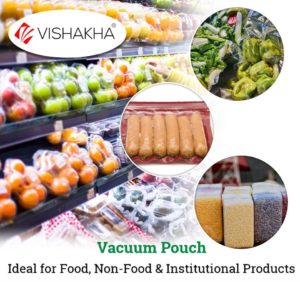In today’s world, where concerns about food waste and environmental sustainability are paramount, innovative packaging solutions have emerged as crucial tools for reducing waste and minimizing the environmental impact of the food industry. Vacuum pouches, a form of airtight packaging, have gained recognition for their role in enhancing food preservation, extending shelf life, and ultimately contributing to a more sustainable food supply chain.
Extending Shelf Life and Reducing Food Waste
One of the primary benefits of vacuum pouches in the food industry is their ability to extend the shelf life of perishable goods. Here’s how it works:
1. Oxygen Removal:
Vacuum packaging involves removing air (and thus oxygen) from the pouch before sealing it. Oxygen is a key factor in food spoilage, as it promotes the growth of aerobic microorganisms, such as bacteria and molds. By creating an oxygen-free environment, vacuum pouches slow down the degradation of food.
2. Inhibiting Microbial Growth:
The absence of oxygen hinders the proliferation of spoilage-causing microorganisms. This means that vacuum-sealed foods remain fresher for longer, reducing the likelihood of food going bad before it can be consumed.
3. Preventing Freezer Burn:
Vacuum-sealed products are also less susceptible to freezer burn, a common issue with frozen foods. The removal of air prevents moisture loss and freezer burn, preserving the food’s texture and flavor.
 Minimizing Food Spoilage
Minimizing Food Spoilage
Vacuum pouches help minimize food spoilage in various ways:
1. Bulk Packaging:
Vacuum packaging is commonly used for bulk items like meat, poultry, and cheese. By sealing these products in vacuum pouches, manufacturers reduce the chances of contamination and spoilage during transportation and storage.
2. Portion Control:
Individual portions of food can be vacuum-sealed, reducing the need to open large containers. This helps consumers manage their food portions more effectively and minimizes food waste at home.
Reducing the Need for Preservatives
In traditional packaging methods, such as using air-permeable plastic or paper, food manufacturers often rely on chemical preservatives to extend shelf life. Vacuum pouches, by contrast, create a low-oxygen environment that naturally inhibits the growth of spoilage microorganisms. This can lead to a reduction in the use of synthetic preservatives, which can have environmental and health implications.

Eco-Friendly Packaging
The sustainability benefits of vacuum pouches extend beyond food preservation:
1. Reduced Packaging Waste:
Vacuum pouches are typically designed to fit snugly around the product, reducing the need for excess packaging material. This results in less packaging waste entering landfills.
2. Energy Efficiency:
The vacuum sealing process is energy-efficient, especially when compared to methods that require refrigeration or freezing for food preservation. This reduces the carbon footprint associated with food storage and transportation.
3. Longer Product Lifespan:
By extending the shelf life of food products, vacuum packaging helps reduce the frequency of replenishment, which, in turn, can lead to fewer emissions associated with manufacturing and transportation.
Conclusion
Vacuum pouches have become valuable assets in the food industry’s quest for sustainability. They offer effective food preservation, reducing food waste at various stages of the supply chain. Additionally, vacuum packaging can help minimize the need for synthetic preservatives and reduce overall packaging waste, making it an eco-friendly choice. As the world grapples with food security and environmental challenges, vacuum pouches represent a positive step toward a more sustainable and responsible food industry.

 Minimizing Food Spoilage
Minimizing Food Spoilage